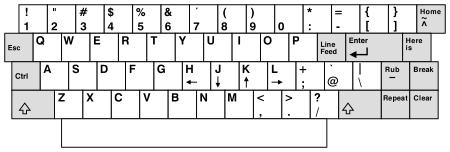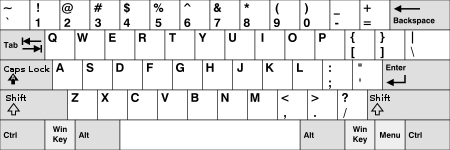How to Read Esc Key in C#

A computer keyboard with the Esc key in the top-left corner

IBM 83-central keyboard (1981), with Esc in the top-left corner of the alphanumeric section
On reckoner keyboards, the Esc key Esc (named Escape key in the international standard serial ISO/IEC 9995) is a key used to generate the escape character (which can be represented as ASCII code 27 in decimal, Unicode U+001B, or Ctrl+[). The escape character, when sent from the keyboard to a computer, often is interpreted by software as "stop", and when sent from the computer to an external device (including many printers since the 1980s, figurer terminals and Linux consoles, for case) marks the start of an escape sequence to specify operating modes or characteristics mostly.
It is now by and large placed at the peak left corner of the keyboard, a convention dating at to the lowest degree to the original IBM PC keyboard, though the key itself originated decades earlier with teletypewriters.
Symbol [edit]

ISO keyboard symbol for "Escape"
The keyboard symbol for the ESC key (which may be used when the usual Latin lettering "Esc" is non preferred for labelling the primal) is standardized in ISO/IEC 9995-seven every bit symbol 29, and in ISO 7000 "Graphical symbols for use on equipment" as symbol ISO-7000-2029. This symbol is encoded in Unicode as U+238B broken circumvolve with northwest pointer (⎋).
Origins [edit]
The name of the equivalent primal on some early Teletype Model 33 keyboards was labeled Alt Fashion..., the culling mode of operation causing the escapement to care for the following i character in a special manner. Much subsequently printers and calculator terminals that would use escape sequences oft would have more than one following byte as part of a special sequence.
Uses [edit]
As well-nigh calculator users are no longer concerned with the details of decision-making their figurer's peripherals, the job for which the escape sequences were originally designed, the escape key was appropriated by application programmers, nigh oft to mean Finish. This employ continues today in Microsoft Windows'southward method of escape as a shortcut in dialog boxes for No, Quit, Exit, Cancel, or Abort, too as a common shortcut cardinal for the Stop button in many web browsers, and to cancel drag and drop operations.[ane] [2] [3]
On machines running Microsoft Windows, prior to the implementation of the Windows cardinal on keyboards, the typical do for invoking the "start" push was to concord down the Control key and printing escape. This key combination still works as of Windows ten.[iv]
Microsoft Windows makes employ of "Esc" for many key shortcuts.[5] Many of these shortcuts have been present since Windows three.0, through Windows XP, Windows Vista, Windows vii, Windows viii, and Windows ten.
In macOS, "Esc" usually closes or cancels a dialog box or canvass. The ⌘ Control+⌥ Option+⎋ Esc combination opens the Strength Quit dialog box, allowing users to terminate not-responsive applications. Another utilize for the Esc cardinal, in combination with the Command cardinal, is switching to Front Row, if installed.
In most calculator games, the escape key is used as a pause push and/or as a way to bring up the in-game menu, usually containing ways to exit the program.

ADM-3A keyboard layout used in vi development, with escape in what is now the tab position
In the 6 family of text editors, escape is used to switch modes. This usage is due to escape being conveniently placed in what is now the tab position on the ADM-3A last keyboard used to develop half dozen, though information technology is now inconveniently placed. This is like to how the extensive modifier keys in Emacs were easily used on the original keyboard (the space-buck keyboard), being placed together, simply these keys have at present been spread around the keyboard, becoming more difficult to use.
The TECO editor uses ESCape as a delimiter when used in one case, and as an execute key when used twice in a row.[6]
Escape sequences on KSR terminals [edit]
Old keyboard Ship/Receive (KSR) printers, and visual display units (VDUs), would ordinarily be controlled by escape sequences sent by the computer to the peripheral device, but there were situations where these devices could be used "off-line" with the keyboard effectively connected to the output device, and so the demand could arise to type escape sequences "by manus" to control the peripheral. Although such devices are long out of use, standard processing[seven] of ANSI Escape sequences very similar to the 1970s VT100, is implemented in both ANSI.SYS and other more modern pseudo-terminal interfaces used in Unix-like environments, ane case being Linux consoles, pregnant newer, higher-level abstractions oasis't changed the fact that typing the escape key followed by something like the half-dozen characters [32;1m affects later on text in output, in this example turning it greenish.
References [edit]
- ^ "Archived copy". Archived from the original on 2006-09-19. Retrieved 2009-02-07 .
{{cite web}}: CS1 maint: archived re-create every bit championship (link) - ^ "Archived copy". Archived from the original on 2009-02-18. Retrieved 2009-02-07 .
{{cite web}}: CS1 maint: archived copy as title (link) - ^ "Cheat Sail for Mozilla FireFox (Key Lath Short Cuts)". scribd.com . Retrieved iv Dec 2016.
- ^ "Ctrl+Esc, U, Enter: Shutdown Windows (XP and earlier)". Retrieved 26 April 2012.
- ^ "Keyboard shortcuts in Windows". support.microsoft.com.
- ^ "Survival TECO".
- ^ "About Unicode and Character Sets", Joel Spolsky, Joel on Software
| Esc | F1 | F2 | F3 | F4 | F5 | F6 | F7 | F8 | F9 | F10 | F11 | F12 | PrtScn/ SysRq | Scroll Lock | Pause/ Intermission | |||||||||
| | Insert | Home | PgUp | Num Lock | ∕ | ∗ | − | |||||||||||||||||
| Delete | Finish | PgDn | 7 | eight | 9 | + | ||||||||||||||||||
| 4 | v | six | ||||||||||||||||||||||
| ↑ | 1 | 2 | 3 | Enter | ||||||||||||||||||||
| ← | ↓ | → | 0 Ins | . Del | ||||||||||||||||||||
Source: https://en.wikipedia.org/wiki/Esc_key

0 Response to "How to Read Esc Key in C#"
Enviar um comentário